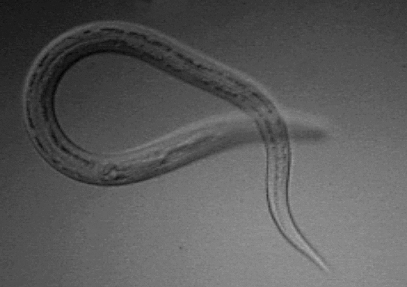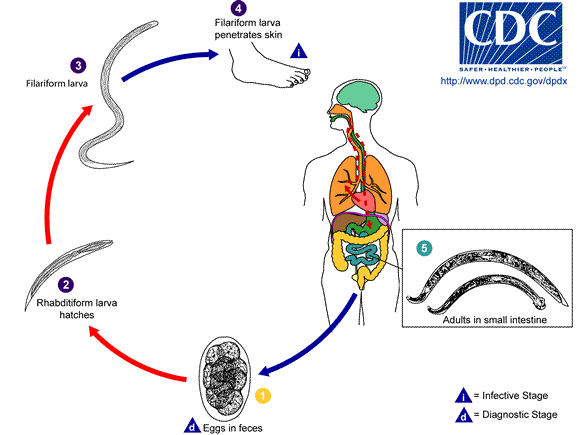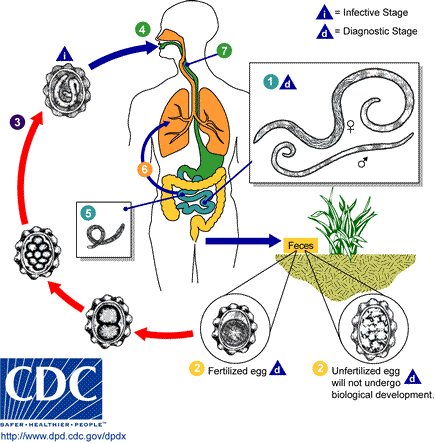|
Hookworms
Hookworms are intestinal, blood-feeding, parasitic roundworms that cause types of infection known as helminthiases. Hookworm infection is found in many parts of the world, and is common in areas with poor access to adequate water, sanitation, and hygiene. In humans, infections are caused by two main species of roundworm, belonging to the genera '' Ancylostoma'' and '' Necator''. In other animals the main parasites are species of ''Ancylostoma''. Hookworm is closely associated with poverty because it is most often found in impoverished areas, and its symptoms promote poverty through the educational and health effects it has on children. It is the leading cause of anemia and undernutrition in developing countries, while being one of the most commonly occurring diseases among poor people. Hookworm thrives in areas where rainfall is sufficient and keeps the soil from drying out, and where temperatures are higher, making rural, coastal areas prime conditions for the parasite to bree ... [...More Info...] [...Related Items...] OR: [Wikipedia] [Google] [Baidu] [Amazon] |
Hookworm Infection
Hookworm infection is an infection by a type of intestinal parasite An intestinal parasite infection is a condition in which a parasite infects the gastro-intestinal tract of humans and other animals. Such parasites can live anywhere in the body, but most prefer the intestinal wall. Routes of exposure and inf ... known as a hookworm. Initially, itching and a rash may occur at the site of infection. Those only affected by a few worms may show no symptoms. Those infected by many worms may experience abdominal pain, diarrhea, weight loss, and fatigue, tiredness. The mental and physical development of children may be affected. Anemia may result. Two common hookworm infections in humans are ancylostomiasis and necatoriasis, caused by the species ''Ancylostoma duodenale'' and ''Necator americanus'' respectively. Hookworm eggs are deposited in the stools of infected people. If these end up in the environment, they can hatch into larvae (immature worms), which can then penetrate t ... [...More Info...] [...Related Items...] OR: [Wikipedia] [Google] [Baidu] [Amazon] |
Necator Americanus
''Necator americanus'' is a species of hookworm (a type of helminth) commonly known as the New World hookworm. Like other hookworms, it is a member of the phylum Nematoda. It is an obligatory parasitic nematode that lives in the small intestine of human hosts. Necatoriasis—a type of helminthiasis Helminthiasis, also known as worm infection, is any macroparasite, macroparasitic disease of humans and other animals in which a part of the body is infected with parasitism, parasitic worms, known as helminths. There are numerous species of the ...—is the term for the condition of being host to an infestation of a species of ''Necator''. Since ''N. americanus'' and ''Ancylostoma duodenale'' (also known as Old World hookworm) are the two species of hookworms that most commonly infest humans, they are usually dealt with under the collective heading of "hookworm infection". They differ most obviously in geographical distribution, structure of mouthparts, and relative size. ''Ne ... [...More Info...] [...Related Items...] OR: [Wikipedia] [Google] [Baidu] [Amazon] |
Ancylostoma Ceylanicum
''Ancylostoma ceylanicum'' is a parasitic roundworm belonging to the genus '' Ancylostoma''. It is a hookworm both of humans and of other mammals such as dogs, cats, and golden hamsters. It is the only zoonotic hookworm species that is able to produce symptomatic infections in humans, with the majority of cases being in Southeast Asia. Discovery and history Since the description of ''Ancylostoma ceylanicum'' by Arthur Looss in 1911, and '' A. braziliense'' by Gomes de Faria in 1910, the two species were considered synonymous because of their apparent similarities in almost all respects. In 1913, comparison of specimens from human, dog, cat and lion infections in India led to the conclusion that they were definitely identical. In 1915 Gomes de Faria described the anatomical structures and concluded that the two were distinct species. Until 1921 ''A. ceylanicum'' was accepted as a valid species. However, in 1922 Gordon made an exhaustive comparison from specimens collected in Braz ... [...More Info...] [...Related Items...] OR: [Wikipedia] [Google] [Baidu] [Amazon] |
Uncinaria Stenocephala
''Uncinaria stenocephala'' is a nematode that parasitizes dogs, cats, and foxes, as well as humans. It is rare to find in cats in the United States. ''U. stenocephala'' is the most common canine hookworm in cooler regions, such as Canada and the northern regions of the US, where it can be found primarily in foxes (40%). ''U. stenocephala'' is also one of the most common hookworms in the UK, called the northern hookworm, but it has a rather low prevalence. ''U. stenocephala ''is' also considered to be zoonotic, because it lives in animals, but can be transmitted to humans. Lifecycle The host ingests an infective third-stage larva. The larva matures to the adult in the small intestine. Eggs are laid in the small intestine and pass out with the feces. The prepatent period is about 15 to 17 days. The eggs hatch in the soil and the larvae molt twice to reach the infective third stage. Infections worsen and amplify when dogs that are regularly kept outside are not routinely deworme ... [...More Info...] [...Related Items...] OR: [Wikipedia] [Google] [Baidu] [Amazon] |
Ancylostoma Tubaeforme
''Ancylostoma tubaeforme'' is a hookworm that infects cats worldwide. Infection can occur through penetration of the skin, ingestion of infected hosts, such as birds, or by directly consuming the organism. ''Ancylostoma tubaeforme'' along with ''Ancylostoma braziliense'' are the two most common hookworms to infect cats, causing anemia and compromising the immune system. Morphology The body of an adult A. tubaeforme is between 7 and 12 millimeters long.Youssefi, M. R., Hoseini, S. H., Hoseini, S. M., Zaheri, B. A., & Tabari, M. A. (2010). First report of Ancylostoma tubaeforme in Persian Leopard (Panthera pardus saxicolor). Iranian Journal of Parasitology, 5(1), 61–63. Signs ''Ancylostoma tubaeforme'' infection may lead to dermatitis, anemia, weight loss, and pulmonary lesions. Life cycle ''Ancylostoma tubaeforme'' larvae may infect a host through oral ingestion or through skin lesions. Larvae ingested by the host pass through the esophagus into the stomach. From there, the ... [...More Info...] [...Related Items...] OR: [Wikipedia] [Google] [Baidu] [Amazon] |
Ancylostoma Braziliense
''Ancylostoma braziliense'' is a species of hookworm belonging to the genus ''Ancylostoma''. It is an intestinal parasite of domestic cats and dogs. Severe infection is often fatal to these pets, especially in puppies and kittens. The infection is particularly endemic in the southern United States. It is most often confused with the zoonotic hookworm species ''Ancylostoma ceylanicum'' because of their uncanny resemblance. ''Ancylostoma braziliense'' larvae can cause accidental infection in humans called Cutaneous larva migrans, cutaneous larval migration or creeping eruption, which produces severe itching in the skin. It is the most common skin infection in tropical region, particularly along the beaches of the Caribbean. Discovery and history When ''A. braziliense'' was described by Gomes de Faria in 1910, and ''A. ceylanicum'' by Arthur Looss in 1911, the two species were regarded as synonym (taxonomy), synonymous because of their apparent similarities in almost all respect. E ... [...More Info...] [...Related Items...] OR: [Wikipedia] [Google] [Baidu] [Amazon] |
Ancylostoma Caninum
''Ancylostoma caninum'' is a species of nematode known as a hookworm, which principally infects the small intestine of dogs. The result of ''A. caninum'' infection ranges from asymptomatic cases to death of the dog; better nourishment, increasing age, prior ''A. caninum'' exposure, or vaccination are all linked to improved survival. Other hosts include carnivores such as wolves, foxes, and cats, with a small number of cases having been reported in humans. Warm and moist conditions are important to allow survival of ''A. caninum'' during the free-living stages of its lifecycle, so it is largely restricted to temperate, tropical, and subtropical regions. In parts of the world where these climatic requirements are met such as Sri Lanka, Southeast Asia, and Malaysia, ''A. caninum'' is the main cause of hookworm disease in canines. Morphology ''A. caninum'' females are typically long and wide, while the males are smaller at in length and in width. Males have a copulat ... [...More Info...] [...Related Items...] OR: [Wikipedia] [Google] [Baidu] [Amazon] |
Hookworm LifeCycle
Hookworms are intestinal, blood-feeding, parasitic roundworms that cause types of infection known as helminthiases. Hookworm infection is found in many parts of the world, and is common in areas with poor access to adequate water, sanitation, and hygiene. In humans, infections are caused by two main species of roundworm, belonging to the genera ''Ancylostoma'' and '' Necator''. In other animals the main parasites are species of ''Ancylostoma''. Hookworm is closely associated with poverty because it is most often found in impoverished areas, and its symptoms promote poverty through the educational and health effects it has on children. It is the leading cause of anemia and undernutrition in developing countries, while being one of the most commonly occurring diseases among poor people. Hookworm thrives in areas where rainfall is sufficient and keeps the soil from drying out, and where temperatures are higher, making rural, coastal areas prime conditions for the parasite to breed. ... [...More Info...] [...Related Items...] OR: [Wikipedia] [Google] [Baidu] [Amazon] |
Ancylostoma Duodenale
''Ancylostoma duodenale'' is a species of the roundworm genus '' Ancylostoma''. It is a parasitic nematode worm and commonly known as the Old World hookworm. It lives in the small intestine especially the jejunum of definitive hosts, generally humans, where it is able to mate and mature. ''Ancylostoma duodenale'' and ''Necator americanus'' are the two human hookworm species that are normally discussed together as the cause of hookworm infection. They are dioecious. ''Ancylostoma duodenale'' is abundant throughout the world, including Southern Europe, North Africa, India, China, Southeast Asia, some areas in the United States, the Caribbean, and South America. Characteristics ''A. duodenale'' is small, cylindrical worm, greyish-white in color. It has two ventral plates on the anterior margin of the buccal capsule. Each of them has two large teeth that are fused at their bases. A pair of small teeth can be found in the depths of the buccal capsule. Males are 8–11 mm long ... [...More Info...] [...Related Items...] OR: [Wikipedia] [Google] [Baidu] [Amazon] |
Anthelminthic
Anthelmintics or antihelminthics are a group of antiparasitic drugs that expel parasitic worms (helminths) and other internal parasites from the body by either stunning or killing them without causing significant damage to the host. They may also be called vermifuges (those that stun) or vermicides (those that kill). Anthelmintics are used to treat people who are infected by helminths, a condition called helminthiasis. These drugs are also used to treat infected animals, particularly small ruminants such as goats and sheep. Anthelmintic medication is also used in mass deworming campaigns of school-aged children in many developing countries. Anthelmintics are also used for mass deworming of livestock. The drugs of choice for soil-transmitted helminths are mebendazole and albendazole; for schistosomiasis and tapeworms it is praziquantel. Types Many early treatments were herbal, such as the oil of herbs of the genus ''Chenopodium'' that were given as anthelmintic treatment for centu ... [...More Info...] [...Related Items...] OR: [Wikipedia] [Google] [Baidu] [Amazon] |
Helminthiases
Helminthiasis, also known as worm infection, is any macroparasitic disease of humans and other animals in which a part of the body is infected with parasitic worms, known as helminths. There are numerous species of these parasites, which are broadly classified into tapeworms, flukes, and roundworms. They often live in the gastrointestinal tract of their hosts, but they may also burrow into other organs, where they induce physiological damage. Soil-transmitted helminthiasis and schistosomiasis are the most important helminthiases, and are among the neglected tropical diseases. These group of helminthiases have been targeted under the joint action of the world's leading pharmaceutical companies and non-governmental organizations through a project launched in 2012 called the London Declaration on Neglected Tropical Diseases, which aimed to control or eradicate certain neglected tropical diseases by 2020. Helminthiasis has been found to result in poor birth outcome, poor cognitiv ... [...More Info...] [...Related Items...] OR: [Wikipedia] [Google] [Baidu] [Amazon] |
Necator Americanus L3 X1000 12-2007
''Necator'' may refer to: * ''Necator'' (fungus), a genus of fungus in the family Corticiaceae * ''Necator'' (nematode), a genus of nematodes in the family Ancylostomatidae {{genus disambiguation ... [...More Info...] [...Related Items...] OR: [Wikipedia] [Google] [Baidu] [Amazon] |





